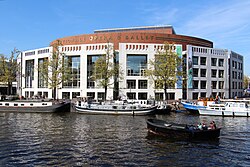Stopera
52°22′02″N 4°54′06″E / 52.36722°N 4.90167°E
| Stopera | |
|---|---|
 The Stopera | |
 | |
| General information | |
| Address | Amstel 1, 1011 PN Amsterdam, the Netherlands |
| Current tenants | Government of Amsterdam, Dutch National Opera, Dutch National Ballet and Holland Symfonia |
| Completed | September 1986 |
| Client | Government of Amsterdam |
| Design and construction | |
| Architect(s) | Bernard Bijvoet & Gerard Holt, Wilhelm Holzbauer and Cees Dam |
The Stopera is a building complex in
The name is an abbreviation of the protest slogan "Stop the Opera" and not a
The Stopera is located in the center of Amsterdam at a bend of the
Next to the Stopera is the Joods Verzetsmonument, a 1988 monument to the Jewish victims of World War II. A remembrance of the Kristallnacht is held at the monument every year.
History

The construction of the Stopera was at least 60 years in the making. As early as 1915, discussions were held about building a new opera house as well as a new city hall. Various sites were considered for the new city hall, until they finally chose an expansive area of the Jewish district which had been largely abandoned during the late 1940s as its occupants were deported to concentration camps.
The Amsterdam city council established a commission in 1955 to create a design with the architectural firm of Berghoef and Vegter. After almost ten years, the council rejected their final proposal in 1964 and held a competition in 1967 for a new design. The council selected a design by Viennese architect Wilhelm Holzbauer. However, plans for the new city hall were delayed again by budget constraints, as were the opera house plans.
In 1979, it was proposed that the city hall and opera house should be combined into one complex. The opera and the Dutch National Ballet would have a shared performance space. In 1980 the Amsterdam city council approved the new design by Cees Dam and Wilhelm Holzbauer. Approval from the provincial and national governments followed in 1981.[1]
The Stopera was a controversial project that met with heavy protests, particularly from the local counterculture and leftwing groups like the squatter movement and Provo movement, leading to riots when construction began in 1982. The project went seriously over budget and the final cost was 112 million Dutch guilders more than originally budgeted.
The opera officially opened on 23 September 1986; the new city hall opened two years later.
References
Further reading
- Max van Rooy en Bas Roodnat De Stopera, een Amsterdamse geschiedenis (1986; Uitgeverij Rap), Dutch publication.
